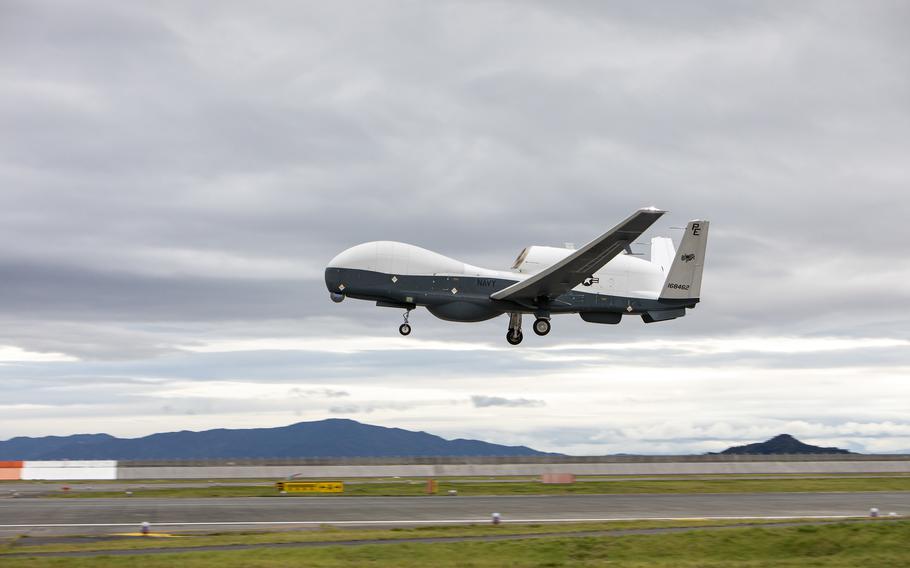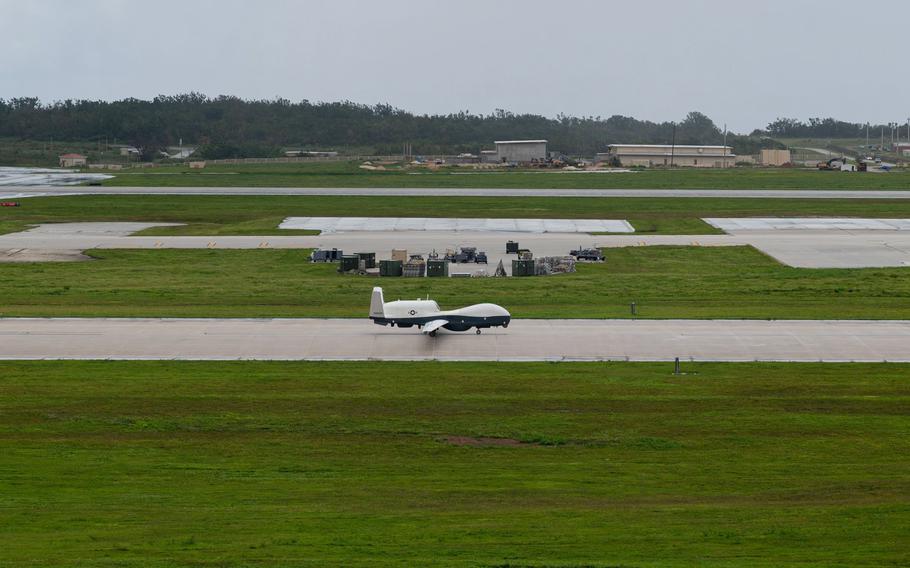
A U.S. Navy MQ-4C Triton assigned to Unmanned Patrol Squadron 19 takes off from Marine Corps Air Station Iwakuni, Japan, Oct. 5, 2022. (David Getz/U.S. Marine Corps)
U.S. Navy surveillance drones are returning to Okinawa six months after their last deployment to the island in response to heightening tensions with China, according to Japan’s Ministry of Defense.
Several MQ-4C Tritons will deploy to Kadena Air Base “within the next few weeks,” Defense Minister Gen Nakatani said during a news conference Tuesday.
“The security environment surrounding our country is becoming increasingly severe,” he added.
The Tritons will join Marine Corps and Air Force Reapers already posted at Kadena.
Nakatani said the Tritons, capable of long-endurance surveillance flights, will enhance intelligence gathering over Japan’s southern island chain, including the Nansei Islands, which stretch from Kyushu to Taiwan.
The aircraft may also temporarily operate from Yokota or Misawa air bases on Honshu for weather or mission-related reasons, according to the Okinawa Defense Bureau.

An MQ-4C Triton assigned to Unmanned Patrol Squadron 19 taxis after landing at Andersen Air Force Base, Guam, Aug. 4, 2023. (U.S. Navy)
The U.S. 7th Fleet is deploying the drones and personnel from Andersen Air Force Base on Guam “to a location in Japan,” spokeswoman Lt. j.g. Sarah Merrill confirmed by email Tuesday. She declined to provide a deployment timeline, citing security concerns.
Merrill said the deployment supports U.S. Indo-Pacific Command and is not in response to a specific incident. However, the defense bureau linked the move to regional tensions, citing Chinese activity near the disputed Senkaku Islands, North Korea’s ship-to-ship transfers, and recent joint bomber flights by China and Russia.
Two Tritons operated from Kadena between May and October last year. The Navy drone resembles the Global Hawk but can descend below 10,000 feet and has reinforced wings and avionics for harsh weather and lightning protection.
The Navy has spent more than $600 million on Triton development, and each drone costs about $32.8 million annually to operate.
Marine and Air Force Reapers have been flying from Kadena since 2023 and 2024, respectively.
MQ-9A Reapers with Marine Unmanned Aerial Vehicle Squadron 3 from Marine Corps Base Hawaii are still deployed to Okinawa, 1st Marine Aircraft Wing spokesman Maj. Joseph Butterfield said by email Tuesday.
The aircraft arrived in August and “provide real-time situational awareness to U.S. Marines, the Joint Force, and regional allies in support of mutual defense,” the wing said in March.
Fewer than six Marine Reapers are at Kadena, the defense bureau said in August.
Air Force MQ-9 Reapers from the 319th Expeditionary Reconnaissance Squadron also moved to Kadena in late 2023 from Kanoya Air Base on Kyushu.
The Reaper, made by General Atomics, is a medium-altitude drone capable of surveillance and armed missions. It can carry Hellfire missiles and laser-guided bombs and costs approximately $56.5 million per unit.